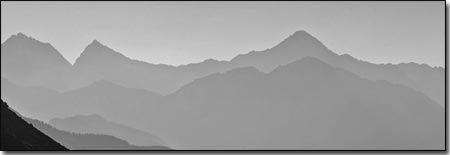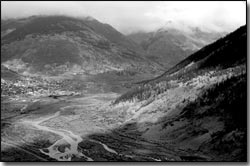|
Conference to investigate the health
of the regionby Shawna Bethell
 |
| The San Juan Mountains, seen
here bathed in evening light near Silverton, will
be the subject of a three-day “State of the
San Juans” conference this weekend
hosted by Silverton’s Mountain Studies Institute.
The annual event is designed to allow researchers
to exchange information while engaging the general
public
in education about the area as well as discussion
on ways to solve problems facing it./Photo by Jared
Boyd |
 For the state of the San Juans to be a positive one, research, education
and public awareness seem to be key. To that end, researchers,
scientists, sociologists, land managers and others will congregate in
the heart of the San Juan Mountains this weekend. They come together
for the Mountain Studies Institute's “State of the San Juans” conference, “San
Juan Mountains Science and Research: Linking Communities, Researchers
and Practitioners.” Mountain
Studies Institute (MSI), based in Silverton, will host
the affair, which is designed to allow researchers of all fields to
share information and discuss the well-being of the local mountain range. For the state of the San Juans to be a positive one, research, education
and public awareness seem to be key. To that end, researchers,
scientists, sociologists, land managers and others will congregate in
the heart of the San Juan Mountains this weekend. They come together
for the Mountain Studies Institute's “State of the San Juans” conference, “San
Juan Mountains Science and Research: Linking Communities, Researchers
and Practitioners.” Mountain
Studies Institute (MSI), based in Silverton, will host
the affair, which is designed to allow researchers of all fields to
share information and discuss the well-being of the local mountain range.
“MSI's role is to collect, synthesize and disseminate information,” said
Mountain Studies Director Ellen Stein. “There are gaps in information
and data that researchers and land-managers utilize when making decisions
about the region. The conference will allow clear dialogue as to what
the data and research needs might be.”
The conference is not only about scientists, however. MSI and the researchers
themselves are hopeful that community members also will attend the meeting,
to learn not only hard facts but what is being done to promote the sustainable
use of the San Juan's natural resources.
Essential to life
Bill Simon, coordinator of the Animas River Stakeholders Group, a group
that focuses on reducing mineral contamination in the watershed, sees
the conference as an opportunity to educate the community.
“The conference is not just about the state of scientific investigation,” he
said. “It is also about the state of communities and how we are reacting
to problems that are developing.”
Simon works in the trenches, so to speak. As a 34-year resident of
the San Juans and a scientist working to improve water quality in an
area riddled with old mines, he sees the repercussions of the contamination
first hand. But he also sees
'Linking Communities, Researchers
and Practioners'
Some of the West's finest researchers
and scientists will present their findings at
the State of the San Juans Conference this weekend,
Sept. 24-26, in Silverton. The conference will
be facilitated by the Mountain Studies Institute,
and anyone interested in the science, history
or sociology of the San Juans is welcome to attend.
Colorado State Attorney General Ken Salazar will
present this year's keynote address.
The conference kicks off Friday with six regional
watershed groups showcasing their efforts. Other
options for Friday include: Collaborative Community
Based Natural Resource Protection and Conservation
Partnerships; presentation of MSI's Scientific
Research Database; as well as breakout discussion
groups in several areas of interest.
Saturday's schedule
will be highlighted by Salazar's discussion
of Colorado water issues. Also on Saturday
is Dr. Bill Baker's scientific opening address, “Science in the San Juans,” and “The
ABC's of Seeking Funds,” presented by a panel
of representatives from various funding organizations.
Scientific presentations covers topics such as:
riparian zones, watershed protection, rare and
endemic plants of the San Juans, recent rock
glacier investigations, ecological restoration,
geologic hazard identification, to name a few.
Sunday is set aside for field trips to nearby
areas including Senator Beck Basin, Chattanooga
Fen, the Eureka Boarding House, and the Old Hundred
Mine/Mayflower Mill. There also will be an Edible
and Medicinal Plant Walking Tour.
– Shawna
Bethell |
possible solutions. The group has remediated
about a dozen mine sites in the decade it's been
in existence, and there are plans for the improvement of 67 more over
the next several years. Since the initial projects, Simon has already
noted improvement in the aquatic life in the waterways. These are all
victories for conservation efforts. But problems do remain.
“The Animas River has the most severe loading to its streams,” said
Simon. Loading is the deposition of heavy metals, such as copper, lead
or zinc, in water via the drainage of acidic rock. Some loading is due
to natural leeching but the problem 4 can be exacerbated by mining,
grazing and road building. Considering that there have been 1,500 recognized
mine sites in the Upper Animas Region, remediation is a huge undertaking.
But there is also moderately strong public support for the stakeholders
groups of which there are six regionally.
Although the Bush Administration has drastically cut funding for projects
such as remediation efforts, Simon feels the general public understands
that with the clean up, things are better than they were before.
“Water is essential to life,” he said. “That keeps the checks and balances
in place. People will demand clean water, and it's more expensive to
clean it at the tap than out here.”
Changes in the landscape
Water quality is not the only challenge in keeping the San Juans pristine.
With the mining era at an end, much of that privately owned land is
now up for sale. Most people don't realize that while the mining companies
did devastate some of the land that they owned, much of it has remained
untouched. In an effort to preserve some of those untouched parcels,
organizations such as the Red Mountain Task Force are working with private
land owners to keep vulnerable areas protected – either through purchase
or easements – from commercial development while allowing public access
to trails and four-wheel drive roads.
“We are making good progress,” said Ken Francis, of the Red Mountain
Task Force, which has helped obtain 7,000 acres in the Red Mountain
area between Silverton and Ouray.
“We have had tremendous support that crosses all political lines,” Francis
said. “But it is all in light of the amount of pressure that has come
about. Pressure to change the landscape.”
Francis explains a scenario that is happening with more and more frequency.
Visitors come to the San Juans for the beauty, but they also become
a threat. They want to purchase land then put up “no trespassing” signs
in areas that, historically, the people have assumed was publicly owned.
“Local residents feel these lands represent our natural and cultural
heritage. We are seeing a strong consensus to keep them pristine,” he
added.
On the map
“The San Juans have been discovered,” said Denny Hogan, of the Forest
Service's Columbine Ranger District. He and his colleagues have seen
firsthand the pressure of that discovery on the San Juans. “Our greatest
obstacle is educating the public in what they can and can't do on public
lands.”
 |
| The Animas River, seen here as
it winds its way from the mountains surrounding
Silverton south to
Durango, will be among the many subjects discussed
this weekend at the Mountain Studies Institute’s
“State of the San Juans” conference.
The watershed is plagued by heavy metal contamination,
both from
natural and manmade sources./Photo by Jared Boyd |
To facilitate the learning curve, the Forest Service has printed a “Forest
Plan Map,” showing where visitors 4 can hike, bike or drive motor vehicles.
Much of Forest Service employees' time is spent stopping people who
may not have taken the time to familiarize themselves with the regulations
and explaining to them what their responsibilities are.
“Often we don't ticket people,” said Hogan, “we just try to talk to
them, but if it becomes a problem we will ticket them and the fines
can be fairly substantial.”
A positive step in the direction of education has been the development
of the San Juan Mountain Center. Located in Silverton, this collaboration
of the Bureau of Land Management, the Forest Service, Mountain Studies
Institute and the San Juan Mountains Association is the first educational
office of its type in the region. Still in its first year, it has been
deemed a success by office personnel who assisted in fielding questions
from 8,500 visitors over 18 weeks this summer.
Overall, Forest Service officials see an increase in motorized travel
and unfortunately, if riders are not responsible in where they travel,
the damage could be considerable to delicate areas of the tundra. That
is why the Forest Plan Maps are so necessary, so people can enjoy their
public lands without causing harm.
“We should be judged by our children as to the legacy we leave them,” said
Hogan. “People should be able to recreate the way they want to but not
destroy the landscape in the process. We have to educate them.”
Those on the front lines of science, research, public awareness and
activism are making strides to keep the San Juans in a healthy state.
Clearly, the burden now falls upon those of us who live and recreate
in those same mountains.
|